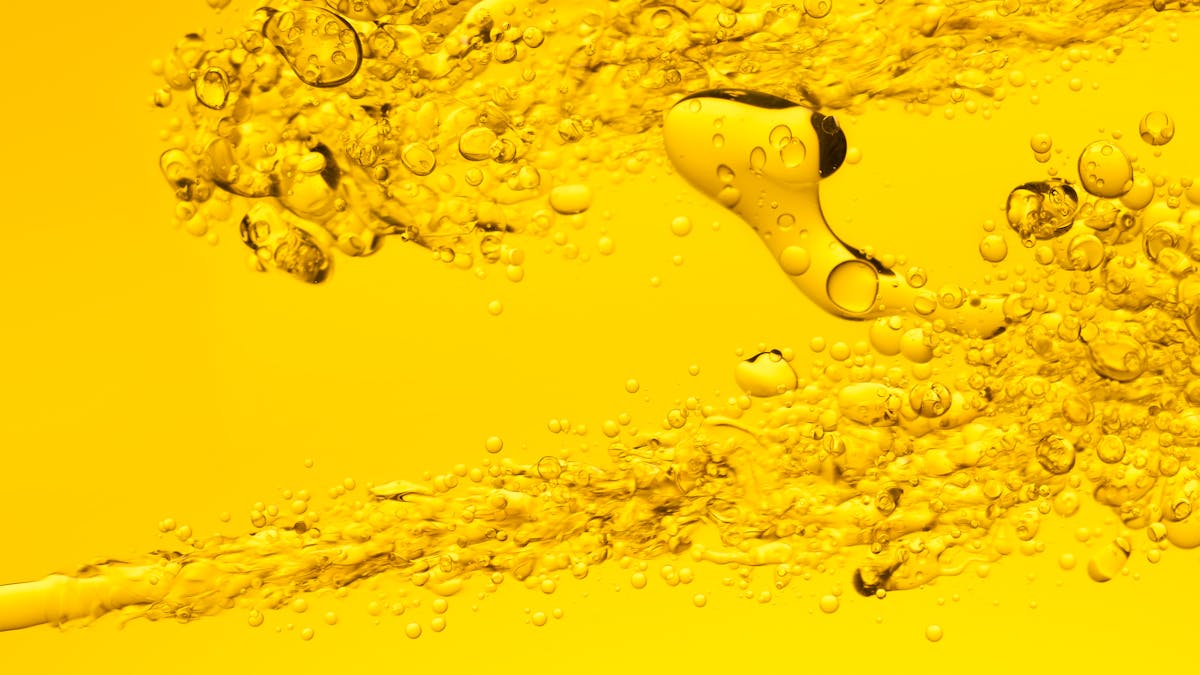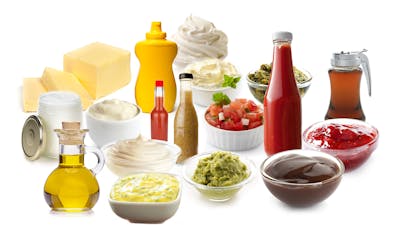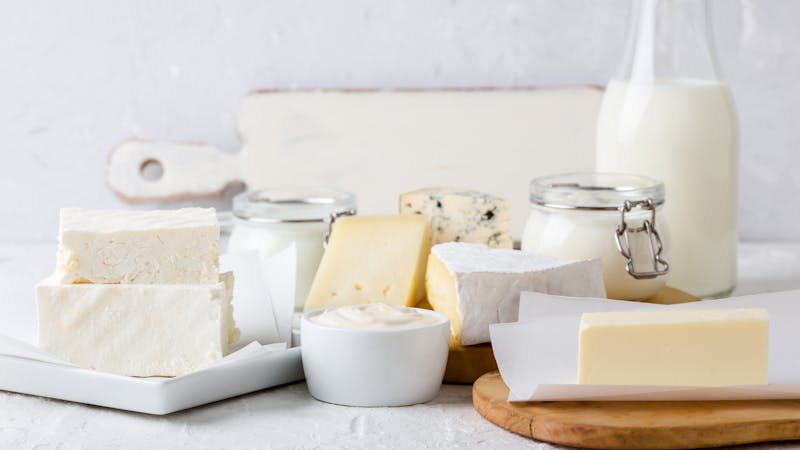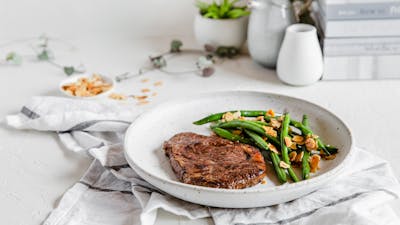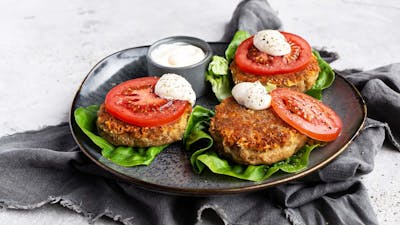Healthy fats on a keto or low-carb diet
- What is fat, and what roles does it play in the body?
- How are fats absorbed in the body?
- What is cholesterol?
- What types of fat should I eat?
- What types of fat should I avoid?
- How much fat should I eat?

What is fat, and what roles does it play in the body?
Dietary fat is found in both animals and plants. Although its main function is to provide your body with energy, it plays several other important roles, including:
- Helping you absorb the fat-soluble vitamins A, D, E, and K1
- Regulating inflammation and immunity2
- Maintaining the health of your cells, including skin and hair cells3
- Adding richness to food, which helps you feel full and satisfied4
The fat in food is in triglyceride form. Each triglyceride contains a glycerol molecule attached to 3 fatty acid chains that are made up of carbon and hydrogen atoms.
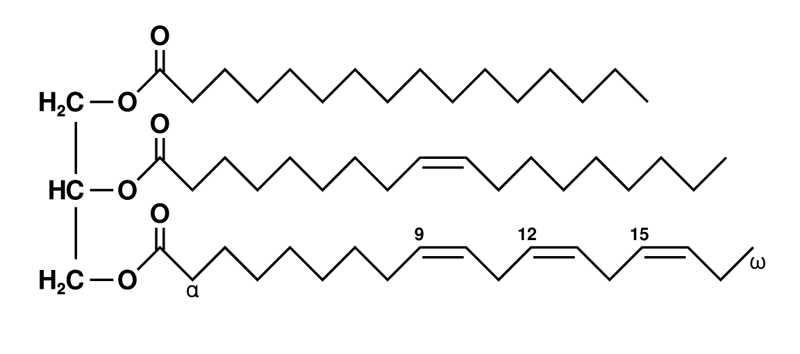
Example of an unsaturated fat triglyceride. Left part: glycerol; right part, from top to bottom: palmitic acid, oleic acid, alpha-linolenic acid.
The fatty acids are classified by the number of bonds they contain between the carbons in their chains, as well as the length of their chains.Saturated vs. unsaturated fatty acids
-
- Saturated fats don’t have any double bonds between the carbons in their chains. They are “saturated” with hydrogen and remain solid at room temperature. Healthy sources of saturated fats include butter, cream and ghee.
Saturated fatty acid myristic acid
-
- Monounsaturated fats have one double bond between carbons in their chains. Healthy sources of monounsaturated fats include olive oil, avocados and nuts.
Monounsaturated fat oleic acid
-
- Polyunsaturated fats have more than one double bond between carbons in their chains. Healthy sources of polyunsaturated fats include fatty fish, meat, nuts and seeds.




Polyunsaturated fat linoleic acid
There are two families of polyunsaturated fatty acids (PUFA’s): omega-3 and omega-6 fatty acids. These are named for the position of the first double bond in their carbon chains.
Fatty acid chain length
- Short-chain fatty acids have 5 or fewer carbons. Short-chain fatty acids are present in small amounts in butter and cream.
- Medium-chain fatty acids (also known as medium-chain triglycerides or MCTs) have 6-12 carbons. Examples of foods that contain medium-chain fatty acids include coconut oil and MCT oil. Butter and cream also contain a small amount of MCTs.
- Long-chain fatty acids have 13 or more carbons. Most of the fats in food are made up of long-chain fatty acids. Examples of foods that contain long-chain fatty acids include meat, poultry, fish, dairy, nuts, seeds, avocado and olives.
You can read more about what fats to eat here.
How are fats absorbed in the body?
Once fatty foods have been digested, their triglycerides are broken down into individual fatty acids and glycerol.
Both saturated and unsaturated long-chain fatty acids are absorbed into the bloodstream, packaged with cholesterol and proteins, and transported throughout your system to be used or stored as body fat.
Short-chain and medium-chain fatty acids are absorbed differently. Instead of being transported throughout your body, they go directly to the liver, where they can be converted to ketones and used as a quick energy source.5 Additionally, they may be less likely to be stored as fat compared with long-chain fatty acids.6
What is cholesterol?
Cholesterol is a waxy substance found only in animal foods. Unlike fatty acids, it doesn’t provide energy. However, your body needs it in order to produce steroid hormones, vitamin D, and bile acids that help digest fat.7
All of your cells make cholesterol. In fact, most of the cholesterol in your blood comes from your body rather than the food you eat.8 Dietary cholesterol usually doesn’t raise blood cholesterol levels much, if at all, and therefore likely doesn’t increase heart disease risk.9
What types of fat should I eat?
We recommend eating fats that occur naturally in food and have been minimally processed.
For several decades the American Heart Association and other health organizations have advised people to reduce their saturated fat intake.10 Unfortunately, that recommendation is based mostly on low-quality observational studies.
Yet most systematic reviews of randomized controlled trials — considered the strongest type of evidence — have failed to show a link between saturated fat and heart disease.11 Because of this, the role of natural saturated fats in a healthy diet is now being reconsidered.
Overall, saturated fat appears to be neutral for health.12 Learn more in our guide to saturated fat.
Saturated fat is found in a number of healthy foods that can – and probably should – be enjoyed on a well-balanced keto or low-carb diet.
What’s more, no food contains 100% saturated, monounsaturated, or polyunsaturated fat. For example, red meat contains roughly equal amounts of monounsaturated and saturated fat, plus a small amount of polyunsaturated fat.
However, in some foods one type of fat is usually predominant. For example, butter is considered a good source of saturated fat, and olive oil is a good source of monounsaturated fat.
Below are several healthy sources of each type of fat.
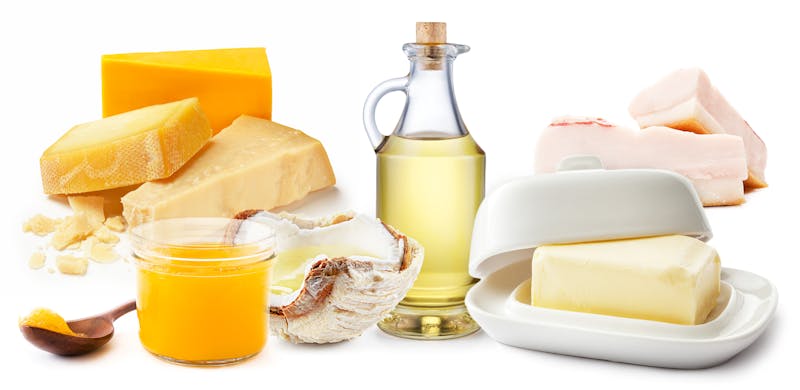



Saturated fats
- Butter and ghee (clarified butter)
- Cream, whipping cream and coconut cream
- Coconut oil13
- Cheese
- Lard and tallow
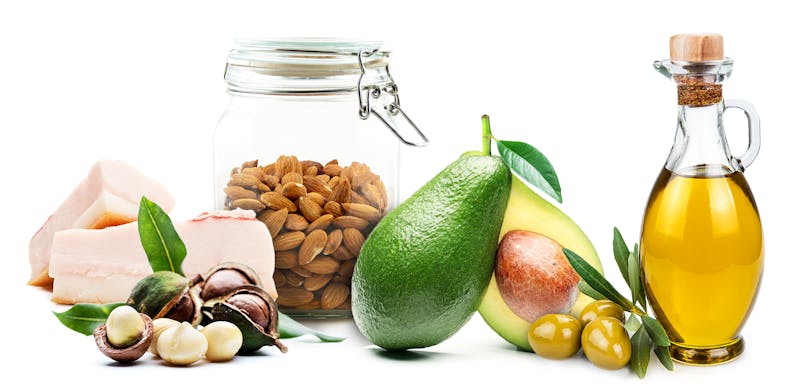



Monounsaturated fats
- Olives and olive oil
- Avocados and avocado oil
- Macadamias and macadamia oil
- Almonds, pecans, peanuts, and other nuts
- Lard and tallow




Polyunsaturated fats
Omega-3
- Fatty fish (salmon, mackerel, herring, sardines, anchovies)
- Grass-fed animals
- Dairy from grass-fed animals
- Eggs from pastured chickens
- Algae
- Chia seeds
- Flaxseeds
- Hemp seeds
- Walnuts
Omega-6
- Found in almost every food, including meat, nuts and seeds.
- Vegetable and seed oils like safflower oil, sunflower oil, soybean oil and cottonseed oil – as well as processed foods that contain them – are often a major source of omega-6 PUFAs in modern Western diets.14 We recommend minimizing these oils because they are highly processed. However, the science on the health risks or benefits is inconclusive. You can learn more in our guide to vegetable oils.
Aim for a low omega-6:omega-3 PUFA ratio
The omega-6 PUFA linoleic acid and the omega-3 PUFA alpha-linolenic acid are considered essential fatty acids because your body needs them but can’t make them on its own. Therefore, you must get them from food.
Alpha-linolenic acid is found mainly in seeds. However, the most important omega-3 fats are EPA and DHA, which are found in fatty fish and grass-fed meat. These long-chain fats are important for brain health and keeping inflammation under control.15 They may also reduce heart disease risk factors, although results from high-quality studies are mixed.16
Your body can convert alpha-linolenic acid to EPA and DHA, but in most people this conversion isn’t very efficient.17
Achieving a balance of omega-3 and omega-6 fatty acids might also be important.
It’s believed our evolutionary diet contained roughly equal amounts of omega-3 and omega-6 fats. However, due to heavy reliance on processed foods, many Western diets today may contain more than 15 times as much omega-6 as omega-3.18
Since at this time it’s unclear how this dietary shift might be impacting our health, we feel it makes sense to mainly stick with the foods our ancestors consumed for thousands of years.
Having fatty fish at least twice a week, choosing meat and dairy products from grass-fed animals when possible, and eating less processed foods can help improve your omega-6:omega-3 ratio.19
The healthiest fats to cook with
Saturated fats such as butter, ghee, coconut oil and lard are the best options for frying and deep frying. These fats are resistant to heat and don’t oxidize when reaching high temperatures, as the less stable polyunsaturated fats in vegetable and seed oils do.20
Some monounsaturated fats like olive oil are also good choices for high-heat cooking because they remain pretty stable when heated.21
It might be best to avoid using high-PUFA vegetable oils when cooking at very high temperatures. When heated, these fats are more likely to become oxidized, or damaged.22
Virgin (unrefined) avocado oil, which is high in monounsaturated fat, is also easily oxidized when exposed to high temperatures.23
At this time, evidence suggests that vegetable oils are probably fine for lower-heat cooking for short periods of time.24 But in order to minimize any risk, we recommend that you cook with butter, lard, or other heat-stable fats and use avocado oil to make salad dressing, mayonnaise, or other condiments that don’t require heating.
More
For more about fats and sauces on a low-carb diet, have a look at our full visual guide:
What types of fat should I avoid or minimize?
We recommend completely avoiding trans fats (also known as partially hydrogenated oils) because of their adverse effects on heart disease risk factors.25
Fortunately, this has become easy to do, as they are banned in Europe and in the process of being eliminated from the US food supply by 2021.
The science is less clear on the health impact of processed vegetable and seed oils. These oils are highly processed and rich in polyunsaturated omega-6 fats, which most of us already get more of than we need.
High-oleic versions of safflower, sunflower, and other oils contain at least 70% monounsaturated fat and very little omega-6 PUFAs. This makes them more stable and less likely to become damaged when heated.26 On the other hand, they’re still highly processed.
Even though there is currently no conclusive evidence that vegetable or seed oils are harmful to health, we recommend consuming natural fats like butter, olive oil, and coconut oil and minimizing the use of most highly processed vegetable oils.
How much fat should I eat?
On a low-carb or keto diet, most people don’t need to count calories or fat grams. While keeping carbs low and protein within a fairly wide moderate range of 1.2-2.0 g/kg of reference body weight per day, most people can eat as much fat as they require to enjoy their meal. This approach often allows people to eat less, lose weight, and improve their health.27
If you still want to calculate fat grams, follow these general guidelines:
The amount of fat you should eat on a keto or low-carb diet depends on a number of things, including your protein and carb intake, your current weight, and your weight goals. Are you trying to lose, maintain, or gain weight?
Figure out your protein and carb needs first, and then fill in your remaining energy needs with fat.
You may have heard that on a keto diet, the more fat you eat, the more fat you will lose. This is likely not true. If you eat more fat than you need to enjoy your food or for energy supplies, this can slow down or stop weight loss, even if you eat very few carbs.28
This also applies to the medium-chain fats found in coconut oil and MCT oil, which are normally burned rather than stored. Your body is less likely to burn its own fat if it has excess dietary fat coming in, regardless of the type.
But although adding less fat at meals can help you burn more of your own body fat, don’t make the mistake of trying to follow a diet that’s low in both carbs and fat. This is a strategy that will ultimately leave you hungry.29 Eat enough fat to enjoy your food and provide the calories you need for your health progress.
Did you enjoy this guide?
We hope so. We want to take this opportunity to mention that Diet Doctor takes no money from ads, industry or product sales. Our revenues come solely from members who want to support our purpose of empowering people everywhere to dramatically improve their health.
Will you consider joining us as a member as we pursue our mission to make low carb simple?
Top posts by Franziska Spritzler
Healthy fats on a keto or low-carb diet - the evidence
This guide is written by Franziska Spritzler, RD, Dr. Bret Scher, MD and was last updated on August 6, 2022. It was medically reviewed by Dr. Bret Scher, MD on August 5, 2022.
The guide contains scientific references. You can find these in the notes throughout the text, and click the links to read the peer-reviewed scientific papers. When appropriate we include a grading of the strength of the evidence, with a link to our policy on this. Our evidence-based guides are updated at least once per year to reflect and reference the latest science on the topic.
All our evidence-based health guides are written or reviewed by medical doctors who are experts on the topic. To stay unbiased we show no ads, sell no physical products, and take no money from the industry. We're fully funded by the people, via an optional membership. Most information at Diet Doctor is free forever.
Read more about our policies and work with evidence-based guides, nutritional controversies, our editorial team, and our medical review board.
Should you find any inaccuracy in this guide, please email andreas@dietdoctor.com.
Intestinal Lipid Metabolism 2001: Intestinal absorption of fat-soluble vitamins [textbook chapter; ungraded] ↩
The British Journal of Nutrition 2007: Fatty acids and immune function: new insights into mechanisms [overview article; ungraded] ↩
Journal of Lipid Research 2009: The outer frontier: the importance of lipid metabolism in the skin [overview article; ungraded]
Journal of Cosmetic Science 2018: Role of internal lipids in hair health [overview article; ungraded] ↩
In clinical trials, meals higher in fat have been shown to increase satiety compared to meals with less fat:
Nutrients 2019: High-fat breakfast meal replacement in overweight and obesity: implications on body composition, metabolic markers, and satiety [randomized trial; moderate evidence]
Nutrients 2019: Using the avocado to test the satiety effects of a fat-fiber combination in place of carbohydrate energy in a breakfast meal in overweight and obese men and women: a randomized clinical trial [randomized trial; moderate evidence] ↩
Life Sciences 1998: Medium chain fatty acid metabolism and energy expenditure: obesity treatment implications [overview article; ungraded] ↩
International Journal of Obesity and Related Metabolic Disorders 2003: Greater rise in fat oxidation with medium-chain triglyceride consumption relative to long-chain triglyceride is associated with lower initial body weight and greater loss of subcutaneous adipose tissue [randomized trial; moderate evidence]
Obesity Research 2003: Medium-chain triglycerides increase energy expenditure and decrease adiposity in overweight men [randomized trial; moderate evidence] ↩
Nutrients 2019: New insights into cholesterol functions: a friend or an enemy? [overview article; ungraded] ↩
It’s estimated that only about 30% of the body’s cholesterol comes from the diet:
Critical Reviews in Food Science and Nutrition 2016: The role of dietary cholesterol in lipoprotein metabolism and related metabolic abnormalities: a mini-review [review article; ungraded] ↩
When most people eat more cholesterol, the body produces less, resulting in little change in blood cholesterol:
Arteriosclerosis, Thrombosis, and Vascular Biology 1996: Dietary cholesterol feeding suppresses human cholesterol synthesis measured by deuterium incorporation and urinary mevalonic acid levels [randomized trial; moderate evidence]
Nutrients 2018: Intake of 3 eggs per day when compared to a choline bitartrate supplement, downregulates cholesterol synthesis without changing the LDL/HDL ratio [randomized trial; moderate evidence]
The following AHA scientific paper reviews the evidence showing no increase in heart disease for those who eat more dietary cholesterol.
Circulation 2020: Dietary cholesterol and cardiovascular risk: A science advisory from the American Heart Association [overview article; ungraded]
Although as we reviewed, their conclusion doesn’t match the science.
↩Circulation: 2013 AHA/ACC guideline on lifestyle management to reduce cardiovascular risk: A report of the American College of Cardiology/American Heart Association task force on practice guidelines [consensus guidelines; ungraded] ↩
Nutrition Journal 2017: The effect of replacing saturated fat with mostly n-6 polyunsaturated fat on coronary heart disease; a meta-analysis of randomized controlled trials [systematic review of randomized trials; strong evidence]
Open Heart 2016: Evidence from randomised controlled trials does not support current dietary fat guidelines: a systematic review and meta-analysis [systematic review of randomized trials; strong evidence] ↩
A 2020 Cochrane review of RCTs showed a reduction in cardiovascular events for lower saturated fat intake, but this effect was modest and only in those who had a significant rise in LDL. This study also found no difference in cardiovascular death or all-cause death. It should also be noted that these studies did not control from which foods the saturated fat came (eg, processed baked goods or minimally processed meat).
Interestingly, of the 12 studies analyzed, 9 showed no significant difference, whereas only 3 did show a difference.
Cochrane Database of Systemic Reviews 2020: Reduction in saturated fat intake for cardiovascular disease [systematic review of randomized trials; strong evidence]
We reviewed this report in more detail here.
Yet other studies have shown no increased risk of cardiovascular outcomes with higher saturated fat intake:
BMJ Open 2014: Dietary fatty acids in the secondary prevention of coronary heart disease: a systematic review, meta-analysis and meta-regression [meta-analysis of randomized trials; strong evidence]
Finally, a three-week study in people with heart disease found that eating a lot of saturated fat increased small and medium LDL particles, at least in the short term. However, this has not been a consistent finding in the literature.
PLoS One 2017: Effects of a very high saturated fat diet on LDL particles in adults with atherogenic dyslipidemia: a randomized controlled trial [randomized trial; moderate evidence]
↩Good source of medium-chain fatty acids ↩
The American Journal of Clinical Nutrition 2005: Origins and evolution of the Western diet: health implications for the 21st century [overview article; ungraded] ↩
Nutrients 2018: Brain health across the lifespan: a systematic review on the role of omega-3 fatty acid supplements [systematic review of randomized trials; strong evidence]
Arteriosclerosis, Thrombosis, and Vascular Biology: Prostaglandins and inflammation [overview article; ungraded]
The Indian Journal of Pediatrics: Essential fatty acids, DHA and human brain [overview article; ungraded] ↩
One 2018 systematic review of clinical trials concluded that EPA and DHA may improve some markers of heart disease risk, such as increasing HDL cholesterol and lowering triglycerides:
International Journal of Molecular Sciences 2018: The differential effects of eicosapentaenoic acid and docosahexaenoic acid on cardiometabolic risk factors: a systematic review
[systematic review of randomized trials; strong evidence]But an even larger systematic review published the same year found that high intake of these omega-3 fatty acids is unlikely to prevent heart attacks or death from heart disease:
Cochrane Database of Systematic Reviews 2018: Omega‐3 fatty acids for the primary and secondary prevention of cardiovascular disease
[systematic review of randomized trials; strong evidence]And most recently, a randomized controlled trial found high-dose EPA reduced heart attacks and cardiovascular death in high-risk subjects with elevated triglycerides:
The New England Journal of Medicine: Cardiovascular risk reduction with icosapent ethyl for hypertriglyceridemia [randomized trial; moderate evidence] ↩
Progress in Lipid Research 2016: Metabolism and functional effects of plant-derived omega-3 fatty acids in humans [overview article; ungraded] ↩
Biomedicine & Pharmacotherapy 2006: Evolutionary aspects of diet, the omega-6/omega-3 ratio and genetic variation: nutritional implications for chronic diseases [overview article; ungraded] ↩
Since we do not have scientific evidence to show this improves long-term health, we cannot evidence-base this recommendation, and we acknowledge it is mostly opinion based. ↩
Journal of Foodservice 2006: Health effects of oxidized heated oils [overview article; ungraded]
Indian Journal of Clinical Biochemistry 2000: Lipid peroxidation in culinary oils subjected to thermal stress [mechanistic study; ungraded] ↩
Czech Journal of Food Sciences 2005: Oxidative changes of vegetable oils during microwave heating [mechanistic study; ungraded]
Indian Journal of Clinical Biochemistry: Lipid peroxidation in culinary oils subjected to thermal stress [mechanistic study; ungraded] ↩
Heating polyunsaturated fats to high temperatures makes them more likely to react with oxygen, leading to the formation of potentially harmful byproducts. Although we are not aware of human studies showing long-term risk, the mechanistic studies are enough for us to caution against their use in high-heat cooking:
Food and Nutrition Research 2011: Determination of lipid oxidation products in vegetable oils and marine omega-3 supplements [mechanistic study; ungraded]
Journal of the American Oil Chemists’ Society 2002: Formation of 4-hydroxynonenal, a toxic aldehyde, in soybean oil at frying temperature [mechanistic study; ungraded] ↩
Journal of Food Science and Technology 2019: Changes in quality and phytochemical contents of avocado oil under different temperatures [mechanistic study; ungraded] ↩
British Journal of Nutrition 2015: Possible adverse effects of frying with vegetable oils [overview article; ungraded] ↩
Consuming trans fats has been shown to raise LDL cholesterol, lower HDL cholesterol, and increase inflammatory markers:
The New England Journal of Medicine 1990: Effect of dietary trans fatty acids on high-density and low-density lipoprotein cholesterol levels in healthy subjects [randomized trial; moderate evidence]
Lipids 2010: Effects of partially hydrogenated, semi-saturated, and high oleate vegetable oils on inflammatory markers and lipids [randomized trial; moderate evidence] ↩
Journal of the American Oil Chemists Society 1967: High-oleic safflower oil. Stability and chemical modification [overview article; ungraded]
Food Chemistry 2013: Frying stability of high oleic sunflower oils as affected by composition of tocopherol isomers and linoleic acid content [mechanistic study; ungraded]
Journal of the American Oil Chemists Society 2013: Performance of regular and modified canola and soybean oils in rotational frying [mechanistic study; ungraded] ↩
In studies, when people are allowed to eat as much fat as needed to feel full, they often end up consuming less overall due to feeling more satisfied:
Nutrition & Diabetes 2017: Twelve-month outcomes of a randomized trial of a moderate-carbohydrate versus very low-carbohydrate diet in overweight adults with type 2 diabetes mellitus or prediabetes [randomized trial; moderate evidence]
Annals of Internal Medicine 2005: Effect of a low-carbohydrate diet on appetite, blood glucose levels, and insulin resistance in obese patients with type 2 diabetes [non-randomized trial; weak evidence]
Nutrition & Metabolism 2005: A low-carbohydrate, ketogenic diet to treat type 2 diabetes [non-randomized trial; weak evidence] ↩
This is based on the clinical experience of low-carb practitioners.[weak evidence] ↩
This is based on the clinical experience of low-carb practitioners.[weak evidence] ↩
